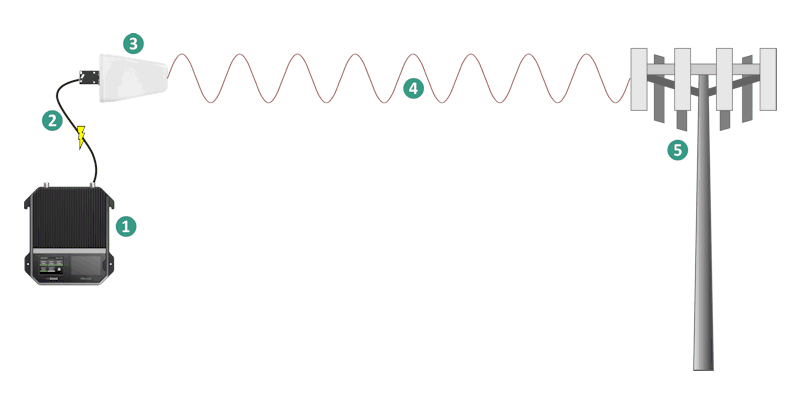Knowledge Base
What is antenna gain? How is antenna gain measured?
Introduction: What is an antenna?
An antenna is a physical device that acts as the interface between two transceivers, electronic devices that both transmit and receive electromagnetic waves, such as the signals used by cellular phones. The antenna receives electrical current from a device (like a cell phone signal booster) through a coaxial cable and and transmits that current through the air as an electromagnetic wave; it also receives electromagnetic waves over the air and sends them as electrical current back through the cable to the device.
An antenna is typically electrically passive, meaning it doesn’t have its own electrical power source or contain transistors.1
 In this simplified example, a cell phone signal booster (1) sends electrical current through a coax cable (2) to a directional antenna (3), which transmits that current as a microwave signal (4) to the antennas on a cell tower (5). This simultaneously also happens in the opposite direction, with the cell tower sending signal back to the booster through its antenna.
In this simplified example, a cell phone signal booster (1) sends electrical current through a coax cable (2) to a directional antenna (3), which transmits that current as a microwave signal (4) to the antennas on a cell tower (5). This simultaneously also happens in the opposite direction, with the cell tower sending signal back to the booster through its antenna.
What is antenna gain?
Antenna gain measures how well an antenna concentrates or focuses the signal it sends and receives in a particular direction. Passive antennas don’t increase the signal strength they send and receive; rather, they are more efficient (positive gain) or less efficient (negative gain).2
More or less efficient than what?
Antenna gain is similar to the example of the flashlight, above. The higher an antenna’s gain, the more efficient it is at sending and receiving electromagnetic waves in a specific direction, compared to an isotropic antenna that sends and receives energy equally in all directions.
To help visualize antenna gain, watch this brief video from Poynting:
How is antenna gain measured?
Because a theoretical isotropic antenna receives and transmits energy of the same intensity in all directions, it is said to have a directivity of 0 dBi (decibels isotropic, pronounced “dee bee eye.”). The 0 (zero) does not mean that the antenna doesn’t send or receive signal at all; rather, it means that it sends and receives signal equally, without regard for the direction the energy goes.
An antenna’s gain is measured by how efficient it is at sending and receiving signal in a specific direction. This is calculated using the decibel scale, which is logarithmic.3 If an antenna has 0 dBi of gain in a certain direction, then it is equally efficient as a theoretical isotropic antenna in that direction. If it has 3 dBi of gain in a certain direction, then it is twice as efficient as an isotropic antenna. 7 dBi of gain is five times as efficient, 10 dBi is ten times as efficient, and 13 dBi is twenty times as efficient. If it has negative gain in dBi in a certain direction, the antenna still receives signal but is less efficient than an isotropic antenna in that direction.
If an antenna is designed to operate across a range of frequencies (a wideband antenna), its gain will vary depending on the frequency. The antenna’s spec sheet will provide a gain figure in dBi for a given frequency; that number is usually the antenna’s maximum (or peak) gain in its most efficient direction.4
A directional antenna—like an LPDA, Yagi, panel, or parabolic dish—is designed to be pointed in a specific direction. (For a cell signal booster antenna, that’s the cell tower you want the booster to communicate with.) This type of antenna has its highest gain or is most efficient along its centerline (or boresight), so pointing it as precisely as possible at the other transceiver (i.e., the cell tower) is going to give you the best signal reception. The higher the antenna’s gain, the narrower its radiation pattern and the more important that it’s pointed directly at the target.
An omnidirectional antenna sends and receives signal in all directions in a 360° circle. The higher the gain of an omni antenna, the flatter its vertical radiation pattern and the more important that it’s at the same elevation as the cell towers you want to communicate with.
To learn more about antenna radiation patterns, watch this brief video from Poynting:
Notes
1 An example of an exception to this is the roof-mounted antenna of the SureCall Fusion2Go Max mobile cell signal booster, which is an active antenna that uses electrical power to improve cell signal reception before sending the signal to the booster for further amplification.
2 Antenna gain is different than amplifier gain. Antenna gain measures an antenna’s directional efficiency; amplifier gain measures how much a cell signal booster increases the strength of the signal it sends and receives.
3 The decibel (dB) is a relative unit of measurement that expresses the ratio of two values of power on a common
(base 10) logarithmic scale
.
4 Some omnidirectional antenna spec sheets state that the figure provided is average gain. In that case, it’s the average of the antenna’s gain on that frequency at multiple points of a 360° circle around the antenna. Some omni antennas have varying amounts of gain in different directions of the same axis.




